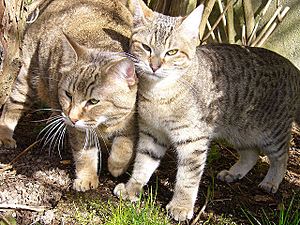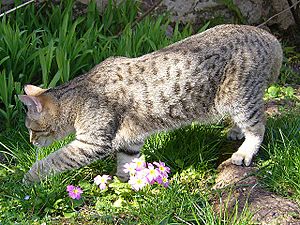Pixie-bob facts for kids
Quick facts for kids Pixie-bob |
|
|---|---|

Short-haired Pixie-bobs.
|
|
| Origin | USA |
| Breed standards | |
| TICA | standard |
| ACFA/CAA | standard |
| CCA-AFC | standard |
| Domestic cat (Felis catus) | |
The Pixie-bob is a special breed of domestic cat. Some people thought they were part bobcat, but DNA tests show they are fully domestic cats. This means they are just like any other house cat when it comes to owning them or taking them to cat shows.
Contents
History of the Pixie-bob
In 1985, a woman named Carol Ann Brewer bought a unique male cat. This cat had a spotted coat, a short tail, and extra toes on its paws (this is called polydactyl paws).
Then, in January 1986, she rescued another large male cat named Keba. Keba also had a short, bobbed tail. People said Keba's father was a bobcat. Even though Keba was very skinny, he still weighed 17 pounds and was so tall he reached Brewer's knees!
Soon after, Keba mated with a neighbor's spotted female cat. In April 1986, kittens were born. Brewer kept one of the female kittens and named her "Pixie." A year later, she started a special breeding program using Pixie as the first cat.
Over the next few years, Brewer added 23 more cats to her program. These cats came from the Cascade Range area and she believed they were born from bobcats and domestic cats mating naturally. She called these special cats "Legend Cats." Other cat breeders also worked with wild-looking barn cats. They all worked together with Brewer to create the Pixie-bob breed we know today.
Brewer and her team successfully registered their new breed with The International Cat Association (TICA) and later with the American Cat Fancier's Association (ACFA). The Pixie-bob was first shown at TICA shows in 1993. By 1998, it became a "Championship" breed, meaning it could compete for top awards.
What Pixie-Bobs Look Like
Pixie-bobs are a fully domestic cat breed. They were specifically bred to look like the wild North American bobcat.
Pixie-bobs can be quite large. On average, they weigh about 11 pounds (5 kg). This is similar to a good-sized regular house cat. Males are usually bigger than females. Most house cats weigh around 8 pounds (4 kg). Pixie-bobs also grow for about 4 years, which is longer than most domestic cats that stop growing after about 1 year.
Most Pixie-bobs have black fur and skin on the bottom of their paws. Their ears have black tips and lots of ear hair. They have black lips and white fur around their eyes, but the skin around their eyes is black. Their chins are white, but often have black skin underneath. Some of their whiskers are black near the root and white towards the tip.
Their fur pattern looks like a bobcat's, often with reddish colors mixed in. Most Pixie-bobs have short hair, but some have long hair. Their eyebrows should be thick, and their eyes should have a triangular shape. When they are kittens, their eyes are blue. As they get older, their eyes change to green or gold. Their tails can be very short, from about 2 inches (5 cm) long, to about the length of their hock (a joint in their back leg). The shape of their head is like a pear, and this is considered a very important feature for the breed.
Pixie-Bob Personality
Pixie-bobs are known for being very smart, friendly, and active cats. They are also brave and enjoy playing with other animals. They make unique sounds like "chirps," chatters, and growls. Most Pixie-bobs do not meow very often, and some don't meow at all!
Most Pixie-bobs are very social with both their owners and new people. Almost all of them like to be in the same room as their owners and will follow them around the house.
Other things that make Pixie-bobs special include:
- They like to gently head-butt people.
- They enjoy fetching balls and playing games.
- Many can learn to walk on a leash.
- They are very intelligent.
- They can understand some human words and phrases.
Pixie-Bob Health
Pixie-bobs are a healthy breed because they are often bred with "legend cats." This means they have a wide variety of genes, which helps prevent health problems that can come from too much inbreeding (when cats that are too closely related breed). Pixie-bob breeders use a special health database called Pawpeds to keep track of health information and make sure their cats stay healthy.
Some rare genetic health issues that have been seen in Pixie-bobs include:
- Cryptorchidism: This is a condition where one or both testicles in male cats do not drop down properly. Only a few cases have been reported since the breed started in the 1980s.
- Delivery problems: A very small number of female Pixie-bobs have trouble giving birth. Cats with these problems are not used for breeding.
- Hypertrophic cardiomyopathy (HCM): This is a heart condition. Only a few cases have been reported in Pixie-bobs since the 1980s. In some of these cases, the Pixie-bob was mixed with other breeds like Bengal or Maine Coon cats. In most cases, HCM happens on its own. Since HCM can be passed down, breeders often do yearly ultrasound checks to make sure their cats' hearts are healthy.
Images for kids
See also
 In Spanish: Pixie Bob para niños
In Spanish: Pixie Bob para niños



